Appendix 1: Foundation Programs aims and progress for 2018

1. DEEP-EARTH FLUIDS IN COLLISION ZONES AND CRATONIC ROOTS (TARDIS II)
Themes 1, 2 and 3, Early Earth, Earth's Evolution and Earth Today, contributing to understanding Earth's Architecture and Fluid Fluxes.
AIMS
This program investigates the role of fluids in the deep mantle and lithosphere, using studies of kimberlites and other volcanic rocks, xenoliths of mantle and crustal rocks in volcanic rocks, ophiolites, and UHP terrains related to subduction zones. Super-reducing, ultra-high-pressure (SuR-UHP: 400-600 km) mineral assemblages in some ophiolites carry implications for the evolution of fluid compositions, reactions and redox states in subduction environments from the surface to the Transition Zone, and suggest a new geodynamic collision process that may improve mineral exploration concepts for paleosubduction regimes. The recent discovery of similar ultra-reduced mineral assemblages in ejecta from Cretaceous volcanoes in Israel suggests a previously unrecognised process of interaction between highly reducing deep-mantle fluids and ascending basaltic magmas. We aim to produce an experimentally testable model for the generation of such fluid conditions in the mantle, to quantify constraints on the geochemical and tectonic processes that have produced SuR-UHP assemblages, and to produce a geodynamic model for these processes.

2018 REPORT
A comprehensive investigation of microstructures and mineralogy in Tibetan ophiolites has defined their evolution, including formation in ancient SCLM within subduction-zone settings, followed by subduction into the upper transition zone and exhumation to the seafloor prior to final emplacement by thrusting during continental collision. Studies of ophiolites in Mexico have revealed similar recycling processes, though not extending all the way to the transition zone. A UHP phase described by us in 2016 from the Luobusa peridotites was successfully synthesised by Prof Luca Bindi (Univ. Firenze) and proved to be an inverse ringwoodite stable only in the Mantle Transition Zone, supporting the subduction-exhumation model for the Yarlung-Zhangbo ‘ophiolites’. Studies on chromitites in ophiolites expanded to Chile, Cuba and Mexico.
Dr Hadi Shafaii Moghadam and his students continued their investigations into the portion of the Tethyan Belt that lies in Iran, integrating field studies, petrology and isotopic geochemistry of granitoid rocks (as probes of the deep crust), volcanic rocks and ophiolites. The evolution of this ‘soft collision zone’ can then be compared and contrasted with the ‘hard collision’ between India and Asia, exposed in Tibet. The project has established a geochemical and geochronological framework, shown the existence of buried Archean-Paleoproterozoic crust in the Georesources - Université de Lorraine east-central part of the orogeny and defined major magmatic flare-ups (Neoproterozoic and Cenozoic) related to major collisions and subduction.
Studies of the suite of highly reduced minerals in the ejecta from Cretaceous volcanoes in Israel (industrial collaboration with Shefa Yamin Ltd., Akko) led to the development of a model involving the interaction of mantle-derived methane and hydrogen with basaltic magmas in conduits or magma chambers near the crust-mantle boundary. Detailed mineralogical studies included further TEM analysis, in collaboration with Prof Martin Saunders (CMCA, UWA), and single-crystal XRD analysis in collaboration with Italian crystallographers (see below). Analyses of microstructures and mineralogy have demonstrated that moissanite in the Israeli ejecta and in Siberian kimberlites has grown from carbon-rich Fe-silicide melts, immiscibly separated from silicate melts. There are clear linkages between the silicide melts that have crystallised SiC and those found within the corundum aggregates found in the Israeli volcanics. This model offers a possible explanation for the wide range of Si isotopes in SiC analysed by SIMS (Perth and Beijing (courtesy of collaborator Prof Li Xian-Hua)). Preliminary noble-gas measurements show that the corundum aggregates contain mantle He, while measurements of gasses included in hibonite aggregates have shown percent levels of hydrogen, consistent with the discovery of the first natural metal hydride (VH2) coexisting with native vanadium in the hibonite aggregates. The hibonite aggregates were the subject of the first detailed description of one of the important parageneses found at Mt Carmel and included similar material from a still undocumented locality in Argentina (collaboration with Prof Fernando Camara (Univ. of Milan) and Prof Luca Bindi).
The work on other mantle rocks continued, with studies of pyroxenites from SE Australia, the Pannonian Basin in Hungary, Cabo Ortegal (Spain) and the Trinity ophiolite (California). Work continued on kimberlites and diamonds in Angola, Siberia and South Africa, including studies of conventional (S, C, O, N) and unconventional (Mg, Fe) isotopes. A major study on the petrography and Sr-C-O isotopes of carbonates in kimberlites worldwide produced consistent criteria for the identification of primary magmatic carbonates and elucidated their role in kimberlite petrology. In collaboration with Prof A. Perchuk (State Univ. of Moscow) we analysed trace element transport across synthetic basalt-peridotite contacts at high P and T to study melt-rock reaction in open systems. Work on the deep crust and its reworking continued in China, with petrological studies of xenoliths and adakites, and geophysical imaging.
See Research highlights:
At the end of rainbow - Where is the pot of gold?
Building the house from the basement: in situ isotopes in kimberlitic carbonates
Olivine grains - new clues to the origin of diamondiferous kimberlites
Micro to global: microstructures reveal mantle secrets beneath the Pannonian Basin, Central Europe
Holy hibonite! - ‘meteoritic’ mineral assemblages in volcanic rocks
Pyroxenite microstructures help unlock deep Earth secrets
Vanadium melts reflect Earth’s most reducing conditions
Carmeltazite - The latest Mt Carmel sensation
Sorting the wheat from the chaff in the source of Australian lamproites
Moissanite in the lithospheric mantle: Crystallisation from metallic melts
Published outputs for 2018
CCFS publications: #958, 974, 978, 992, 993, 1030, 1034, 1054, 1055, 1101, 1106, 1107, 1108, 1124, 1126, 1150, 1156, 1160, 1174, 1179, 1183, 1184, 1192, 1195, 1196, 1197, 1201, 1202, 1205, 1206, 1211, 1212, 1216, 1229, 1244
<25 Conference Abstracts

2. GENESIS, TRANSFER AND FOCUS OF FLUIDS AND METALS
Themes 2 and 3, Earth’s Evolution and Earth Today, contributing to understanding Earth’s Fluid Fluxes.
AIMS
This program embodies a holistic approach to ore deposit research, acknowledging that the genesis of mineral occurrences requires the conjunction in time and space of three main independent parameters: fertility, lithosphere-scale architecture, and favourable transient geodynamics. In this context, the integrated studies in this Flagship program address the critical link between metal source fertility and four-dimensional evolution of multi-scale fluid pathways that ensure efficient mass and fluid flux transfer between the mantle and the upper crust. Our studies test the hypothesis that the genesis of sizeable mineral deposits is the end product of self-organised critical systems operating from the scale of the planet all the way to the very focused environments where ore deposits can form. This Flagship Program is not commodity-focused but rather looks at the basic commonalities among various mineral systems to unravel the main constraints in the formation of ore systems.

2018 REPORT
In 2018, the ongoing projects reached some important milestones. Module 1 (Fertility) focused on unravelling the global cycle of metals. Outcomes include the calibration of a new oxybarometer that can be used to evaluate the copper fertility of porphyry belts and to track the evolution of Earth’s oxygen fugacity from the Hadean through the Eoarchean. We also defined new fertility indicators for porphyry copper mineralisation based on the trace-element composition of zircon. This work is integrated with a series of industry-funded projects on mineralisation in arc environments, mainly the Philippines, Indonesia and Chile-Argentina.
n the Ivrea Zone of Italy, mafic and ultramafic pipes that intrude into the lower crust illustrate how the lower continental crust can be fertilised with mantle-derived metals and volatiles, which then can be remobilised into upper-crustal ore systems. World-class mineral deposits along the margins of lithospheric blocks may thus be the result of both favourable crustal architecture (focusing of magmas and fluids) and localised volatile and metal enrichment of the lower crust related to mantle-derived hydrous metasomatism.
Module 2 (Architecture) continued on the premises that ore deposits are loci on Earth where energy and mass flux are greatly enhanced and focused. They act as magnifying lenses into the mechanisms of metal transport, fractionation and concentration through the continental lithosphere, providing new constraints on its poorly known metallogenic architecture. Studies of the geochemical signatures of metasomatised mantle rocks and magmatic-hydrothermal mineral systems located at varying crustal depths reveal that anomalously gold (Au)- and tellurium (Te)-rich magmatic sulfides are associated with alkali-enriched magmas emplaced in the lower crust. These sulfides share a common Au-Te-rich “metallogenic DNA” with ores associated with upper crustal porphyry and epithermal systems. They define a trans-lithospheric metallogenic continuum with the underlying metasomatised lithospheric mantle.
Module 3 was, for the first time, able to couple recently produced solidii for carbonated basalts and sediments at pressures and temperatures relevant to upper mantle conditions with geodynamic modelling. This was accomplished through a robust modelling framework previously applied to decarbonation of subducting slabs and decarbonation within intracratonic settings. In the Ivrea Zone a section of the lower crust and lithospheric mantle was deformed during the Variscan Orogeny, and carbonated alkaline pipes were emplaced over a time span of ca 40 Ma, following a crustal underplating event at ca 288 Ma. We used a coupled 2D petrological-thermomechanical approach to geodynamically model the processes that led to the Variscan continental collision and subsequent emplacement of the alkaline pipes. The generic model involved: 1) closure of the Rheic Ocean through subduction of oceanic crust and related metasomatism of the lithospheric mantle, 2) high-temperature metamorphism of the lower crust associated with continental collision, preceding 3) a crustal underplating event, and 4) subsequent partial melting of metasomatised lithospheric mantle domains during gravitational collapse of the orogen to source the alkaline pipes. We varied the thermal ages of the intervening oceanic crust (40, 60, and 80 Ma) and the rheological strength of the lower crust: wet quartzite, plagioclase An75, and mafic granulite. Our results show three scenarios, controlled by the rheology of the lower crust. 1: the wet quartzite model features widespread H2O and CO2 metasomatism of the lithospheric mantle, but little melt productivity due to the presence of an overthickened crust. 2: the 40 Ma plagioclase An75 model generates high-temperature metamorphism of the lower crust, the metasomatism of the lithospheric mantle, and the crustal underplating event, but the relative timings are wrong. 3: the 80 Ma mafic granulite model is the only one that reproduces the timing relationships between high-temperature metamorphism, the magmatic underplating event, and localised melting of metasomatised domains of the lithospheric mantle. However, scenarios 1 and 2 may provide information about tectono-magmatic processes at craton margins, including metasomatism and fertilisation of the lithospheric mantle with implications for the localisation of mineralised camps at the regional scale.
See Research highlights: 49, 59-60, 62
Atmospheric sulfur is recycled into the continental crust during supercontinent formation
Building the house from the basement: in situ isotopes in kimberlitic carbonates
CO2 degassing - a new model approach to melting of mantle lithosphere
A giant step towards a unified model for mantle magmatism
Volatile elements and metasomatism: how to move things around in the lithosphere
The power of a systems approach to mineral and petroleum exploration in sedimentary basins
Can olivine’s temperature diagnose the diamond potential of a kimberlite?
Published outputs for 2018
CCFS Publications: #976, 987, 1024, 1025, 1026, 1028, 1040, 1045, 1059, 1066, 1125, 1161, 1162, 1169, 1175, 1176a, 1187, 1188, 1189, 1191, 1198, 1208, 1210, 1214, 1223, 1243, 1316
24 Conference Abstracts

3. MODELLING FLUID AND MELT FLOW IN MANTLE AND CRUST
Themes 2 and 3, Earth’s Evolution and Earth Today, contributing to understanding Earth’s Architecture and Fluid Fluxes.
AIMS
Many aspects of Earth Science, from ore deposits to giant earthquakes, depend critically on the complex interaction of solids and fluids. Numerical simulation of these processes and effective visualisations of the results is critical to understanding how these Earth system components work, but our ability to do this is currently very limited. Flagship Program 3 is developing the next generation of numerical codes and aims to refine the thermodynamic parameters involved by integrating high- pressure experiments to handle these complex problems. This will lead to important improvements in the quantification and visualisation of Earth processes, and will be applied to a variety of geodynamic situations.
The new high-pressure experimental group at Macquarie joins this initiative to provide input on physico-chemical parameters of minerals, melts and fluids in the deep mantle, the composition of melts that infiltrate the lithosphere, and their effects on its geodynamics and stability.
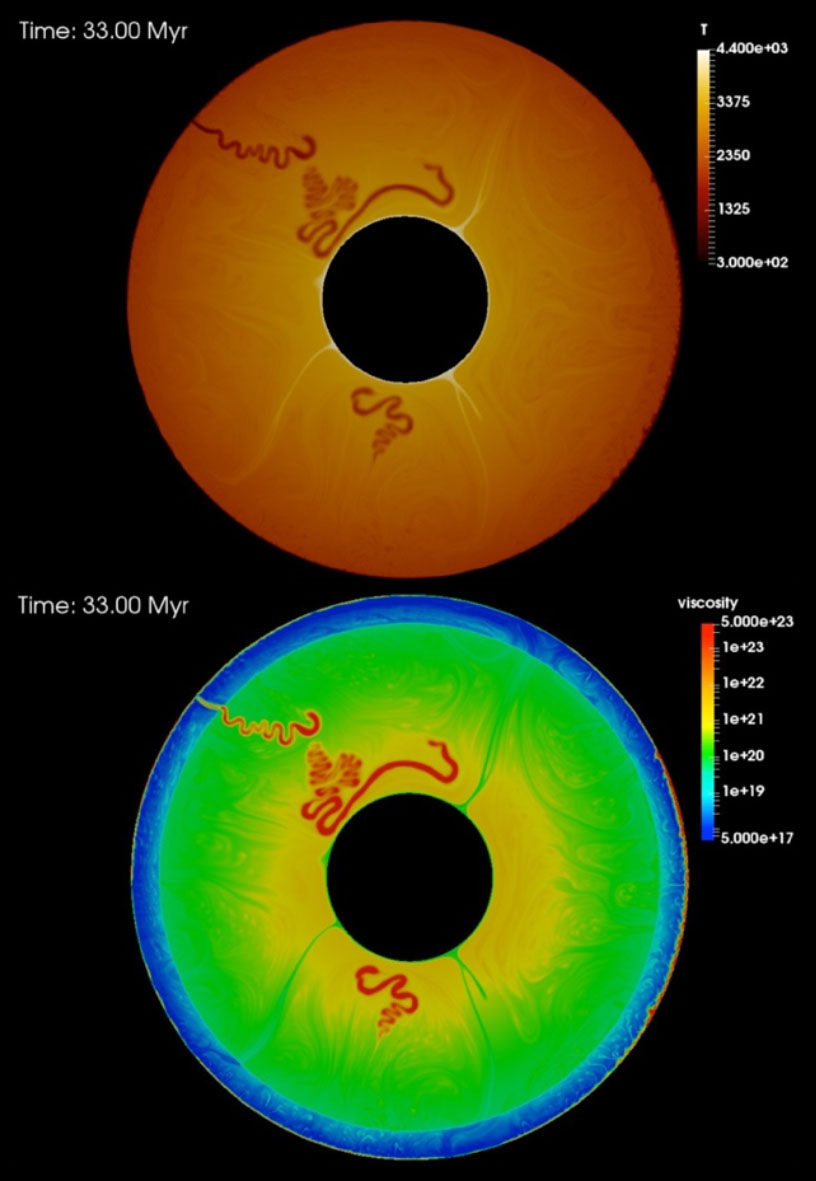
Figure 1. Snapshot of temperature (top) and Viscosity (bottom) of a terrestrial exoplanet with a composition expected for early galactic history. Lower total iron in the interstellar media leads to a lower core, and the planet has a higher concentration of heat-producing elements. Tectonic activity is extremely high on such planets.
2018 REPORT
The seismic imaging of the Chinese crust and lithosphere continued with contributions published on the Balikun Basin, Northern Ordos, western Junggar (Northwest China) and intraplate Northeast China. The program also contributed to constraining the crustal and uppermost mantle structure of both southern California (using ambient noise tomography) and the Western‐Central United States (using probabilistic inversion), as well as the mantle transition zone beneath NE Asia.
Postdoc Siqi Zhang, who drove the technical innovation of the numerical codes, moved on in late 2018. Advances in the numerical stream include new functionality to simulate melt migration through the mantle and crust using statistical approaches, simulating the interaction of impactors and tectonics throughout the Archaean, understanding the initiation of tectonics in Earth’s history and constraining the tectonic evolution of terrestrial exoplanets with different compositions to the Earth. The latter was the subject of a keynote at the 2018 ISSI (International Space Science Institute) in Bern, Switzerland, on Isotopes in Solar System evolution; and the initiation of plate tectonics was an invited keynote at Royal Society Meeting on plate tectonic evolution in London, March 2018, as well as an invited paper contribution to Proceedings of the Royal Society.
High-pressure experimental projects are being conducted to investigate the reaction of mantle peridotite with melts of very different materials, including sedimentary rocks and mica-rich assemblages in the mantle. Two rocks are juxtaposed in the same capsule and heated to a temperature above the melting point of one rock but below the other. The result is a layered reaction zone in which some elements (major and trace) are concentrated in specific zones because of their distinctive mineralogy. An example is the restriction of potassium to a single zone containing mica (Fig. 2) even though it started the experiment in the lower zone where potassium is essentially absent after the experiment. These reaction zones are very effective in fractionating elements and could improve our understanding of the origin of unusual melt types such as those seen in cratonic alkaline rocks and post-collisional volcanoes.
The renovation and expansion of the high-pressure experimental laboratory made great advances in April 2019 with the installation of two multi-anvil presses, which were lowered into position through a removable roof. The larger MAX2003 is a cubic anvil set-up, and is complemented by a Walker module in the smaller 1000 ton-press. See Technology Development
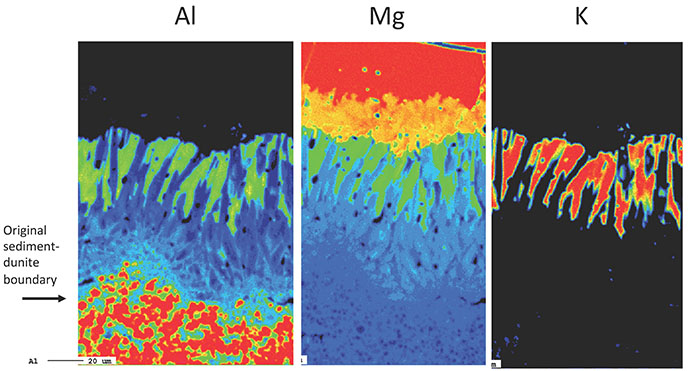
Figure 2. Element maps of experimental reaction zones between peridotite (top) and melts of subducted sediment (bottom). CPotassium (right) is concentrated in a central zone that was originally in the K-free peridotite. The orange zone (centre) is orthopyroxene formed from reacted olivine.
See Research highlights:
A giant step towards a unified model for mantle magmatism
Persistent ancient oceanic slab hovers in the upper mantle of western China?
Reaction of subducted marine sediment with peridotite produces saline fluid inclusions in diamonds
A new mechanism for the formation of diamond-bearing eclogites?
Published outputs for 2018
CCFS Publications: #984, 1012, 1029, 1032, 1102, 1118, 1119, 1157, 1163, 1164, 1170, 1190, 1193, 1203, 1248, 1264, 1270, 1274, 1309, 1311, 1314, 1348, 1349, 1350, 1351
27 Conference Abstracts

4. ATMOSPHERIC, ENVIRONMENTAL AND BIOLOGICAL EVOLUTION
Theme 1 Early Earth, contributing to understanding Earth’s Architecture and Fluid Fluxes.
AIMS
We investigate how the evolution of life and ore deposits were linked to the changing whole-Earth System, focusing on planetary driving forces that affected all the different shells of the planet, to develop a 4-dimensional conceptual framework of Earth evolution. Given the broadly comparable petrological evolution of Earth and Mars, we also aim to put forward new working hypotheses on how life and mineral systems may have formed and evolved on the red planet and are involved in NASA’s Mars2020 landing site selection process.
This program will test the hypothesis that the evolution of life and the genesis of sizeable mineral deposits are the end products of systems operating at the scale of the planet all the way down to the specific environments where life flourished and mineral deposits formed. A component of the program will focus on Mars to investigate whether the evolution of life and the genesis of mineral systems on the red planet operated in a broadly similar fashion. We evaluate the relative importance of:

1) the threshold barriers that form in specific environments, creating strong chemical and energy gradients in the crust, and the self-organised behaviour of mineral systems and life;
2) the evolving nature of ‘traps’ at the lithosphere-hydrosphere boundary, where life and ore deposits developed through time;
3) the global-scale cycles of key elements and heat transfer essential for the evolution of life and formation of ore deposits and
4) the 4-D evolution of the pathways that connect different geochemical reservoirs through time, linked to the changing tectonic style of the planet, as a guide to understanding biological and ore deposit evolution through time.

Figure 1. Interpolated model of MIF-S within Capricorn Orogen. a. Location and geology of the Proterozoic Capricorn Orogen between the Archean Pilbara and Yilgarn cratons in Western Australia. b. Interpolated model of Δ33S for Proterozoic samples of the Capricorn Orogen by ordinary kriging to show that MIF-S occurs in Proterozoic rocks located along the margins of the Archean Pilbara and Yilgarn cratons.
2018 REPORT
In 2018, CCFS Flagship Program 4 was engaged in a wide range of research activities, from continuing investigations of the habitats and biogenicity of the earliest evidence of life on Earth to the adaptation of life across the Great Oxygenation Event, sulfur isotopes in the crust, and the changing nature of tectonics over time.
One of the highlights of the group has been a much more thorough understanding of how sulfur is produced and cycled through the crust and preserved in ore deposits. It turns out it is a complex process that can be tied to the supercontinent cycle, as described by Crystal LaFlamme and others in a series of papers published in 2018 (CCFS publication #1208, Fig. 1). A highlight of the year was that Crystal LaFlamme was awarded a Tier II Canada Research Chair in Sulfur isotope geochemistry at Carleton University, Canada.
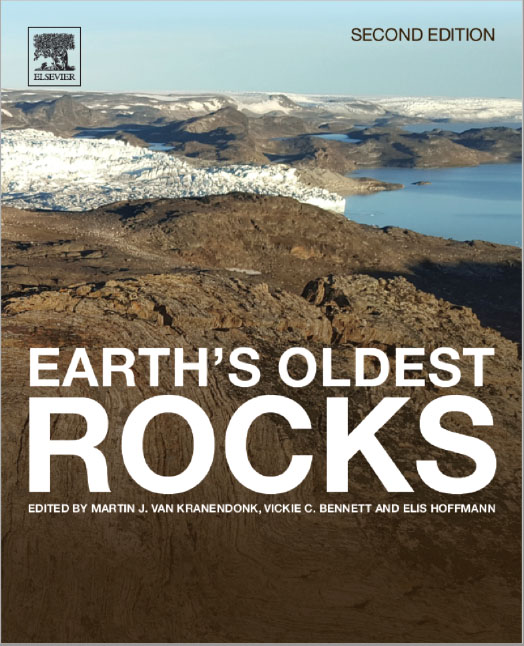
Another publishing highlight in 2018 was the second edition of Earth’s Oldest Rocks, edited by M. Van Kranendonk, V. Bennett, and J. Elis Hoffmann, published by Elsevier (left). With over 40 chapters by more than 120 authors, key features of the book are:
• Advances in early Earth research since 2007 based primarily on evidence gleaned directly from the rock record
• More than 50% of the chapters in this edition are new, and the rest of the chapters are revised from the first edition, with more than 700 pages of new material
• Comprehensive reviews of areas of ancient lithosphere from all over the world, and of crust-forming processes
• New chapters on early solar system materials, composition of the ancient atmosphere-hydrosphere, and overviews of the oldest evidence of life on Earth, and modelling of early Earth tectonics.
Dr Raphael Baumgartner’s (post-doc at UNSW) work on tiny samples of drillcore material from Dresser Formation stromatolites continued to shine. Through nitric acid etching of heavily sulfidised stromatolites, he has discovered trapped organic material - including strands of microbial Extrapolymeric substance (EPS) and probable microfossils - as well as biomineralised microbarite spheroids and a very distinctive ‘spongy’ pyrite that is also associated with microbial activity.
The work has been difficult to get published because of the high bar set by the null hypothesis for early life studies, but there are now four papers resubmitted and will soon be published.
Other FP4 activities included the fourth Astrobiology Australasia Meeting held in Rotorua, New Zealand (June 25-29), followed by the “Grand Tour” field trip across Western Australia consisting of a 10-day outback camping experience on a transect back through time from the living stromatolites at Shark Bay to the 3.5 billion-year-old stromatolites of the Dresser Formation in the Pilbara Craton. Growing in popularity, the 2018 version of the trip had 45 paying participants and a support crew of 5. It is doubtful we will do such a large trip again, as there was some concern about the amount of time people had on some of the smaller, more detailed outcrops. Nevertheless, it was a fun-filled excursion with much delight for many newcomers to Australia, including a ride on the back of tray-back utes through a burning spinifex fire!
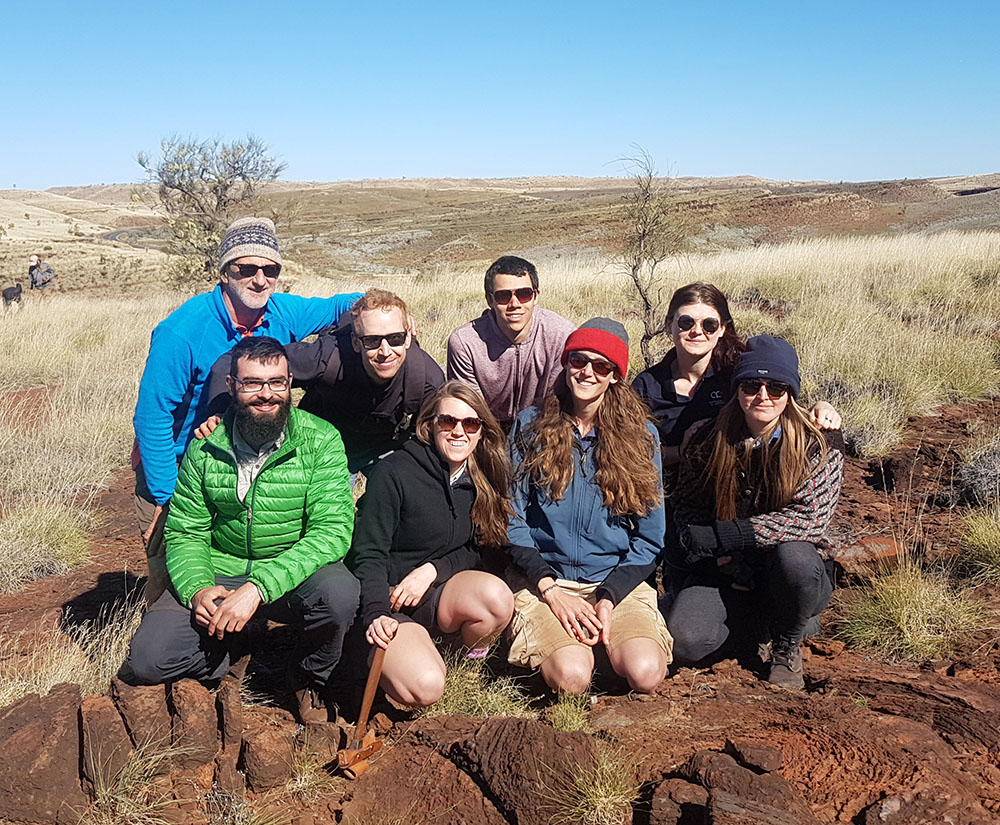
Group photo of Australian Centre for Astrobiology team - UNSW - Astrobiology tour, Pilbara, WA (Martin Van Kranendonk).
In October, four members of FP4 travelled to Glendale, California, to participate and vote in the last of NASA’s Mars2020 landing site workshops to select the final landing site of the top three remaining sites. Van Kranendonk presented a talk to the assembled crowd on “A Mars2020 mission to Columbia Hills: Risk minimisation through ground truth” in which he outlined the benefits of returning to the Columbia Hills site previously visited by the Spirit Rover, and the higher risk of venturing to a new locality, as related to finding signs of life. In the end, the argument was not persuasive, and NASA decided to send Mars2020 to the delta in Jezero Crater.
Finally, Stefano Caruso (UWA) is to be congratulated on completing his PhD on “Geological controls on the fractionation of multiple sulphur isotopes in Archaean mineral systems”.
Published outputs for 2018
CCFS Publications: #980, 1017, 1022, 1024, 1025, 1026, 1028, 1125, 1191, 1208, 1240, 1255, 1322, 1323, 1324, 1328, 1345, 1346, 1347
8 Conference Abstracts

5. AUSTRALIA’S PROTEROZOIC RECORD IN A GLOBAL CONTEXT
Themes 2 and 3, Earth’s Evolution and Earth Today, contributing to understanding Earth’s Architecture.
AIMS
Earth’s history is considered to have been dominated by cycles of supercontinent formation and breakup. This program tests this hypothesis and its relevance to Australia’s geological evolution, assessing Australia’s positions during the supercontinent cycles by examining the paleomagnetic, petrological and detrital provenance record of the Australian and adjacent continents.
By studying primarily Australian rocks and comparing the results with global analogues, we aim to extend our knowledge about supercontinent cycles and the evolution of the Australian continent to the Paleoproterozoic or even further back in time. Such knowledge is fundamental for understanding the first-order fluid cycles that controlled the formation and redistribution of Earth resources, and the establishment of a 4D global geodynamic model covered in other Flagship Programs.
2018 REPORT

PhD student Hamed Gamaleldien resting during field work in Egypt’s Eastern Desert.
Research on the Yilgarn dyke swarms by two PhD students, Camilla Stark and Yebo Liu, has made breakthrough discoveries, and the results are being published. Geochronological and geochemical work on the newly discovered 2.62 Ga, 1.89 Ga and 1.39 Ga mafic dyke swarms are all published (see papers by Stark et al., 2018, CCFS publications #1068, 1246, 1285). Of the palaeomagnetic results, one paper (CCFS publication #1123) is in press, and papers on high-quality 2.62 Ga and 1.39 Ga poles will be submitted in 2019. Two papers on the Bunger Hills dykes of the East Antarctic craton report the first Precambrian palaeomagnetic pole for the East Antarctica (and Mawson) Craton. The new results confirm the putative ~40˚ late Neoproterozoic intraplate rotation within the proto-Australian continent (Li & Evans, 2011 Geology, CCFS publication # 117). These latter results were published in Scientific Reports (CCFS publication #1247).
PhD student Hamed Gamaleldien resting during field work in Egypt’s Eastern Desert.
Palaeomagnetic results from the 1.8 Ga Hart Dolerite of the Kimberley craton led to a new conceptual model, in which the Proterozoic supercontinent Nuna was formed in two-stages (CCFS publication #1238).
Numerous exciting new findings, supported by Li’s ARC Laureate Fellow project, have been published in 2018-2019. The northern Queensland team had two papers published in Geology documenting, for the first time, the 1.6 Ga final Nuna suture in Australia (CCFS publications #1143 and #1207). In a 2019 publication (CCFS publication #1242), we produced a model showing the superposition of a 1.2 Ga superocean cycle with a 600 Myr supercontinent cycle. Both articles have generated a huge global publicity, including radio and TV interviews (see pp. 31-32).
Writing up of palaeomagnetic results from the Yilgarn and Kimberley cratons will continue in 2019.
See Research highlights:
Published outputs for 2018
CCFS Publications: #1033, 1039, 1043, 1068, 1069, 1121, 1167, 1207, 1241, 1246, 1247, 1260, 1263, 1265, 1275, 1282, 1283, 1285, 1286, 1288, 1294, 1304, In Press #1123, 1182, 1238, 1242, 1306
20 Conference Abstracts
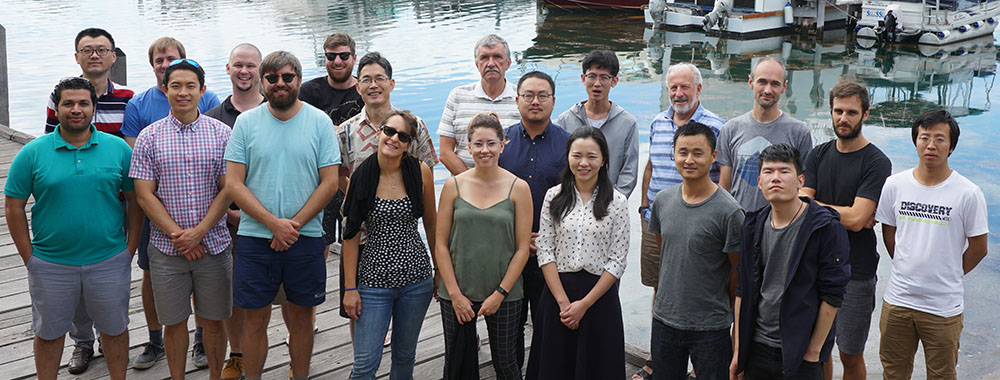
Li’s Laureate team at their annual science retreat, Mandurah, March 2018.

6. FLUID REGIMES AND THE COMPOSITION OF EARLY EARTH
Themes 1 and 3, Early Earth and Earth Today, contributing to understanding Earth’s Architecture and Fluid Fluxes.
AIMS
Zircon crystals are currently the only material that records events in the first 500 million years of Earth’s history, since no rocks have survived from this period and no other minerals have been established as Hadean in age. There is growing evidence from the study of these zircon crystals that the Earth stabilised rapidly after accretion and that both solid rock and liquid water were present within 150 million years of its formation. This program uses the geochemical signatures of zircon crystals from all known Hadean and early Archean localities, together with geochemistry of the oldest known rocks and the application of geophysical and geochemical modelling, to establish how the first crust formed, why it was destroyed and the role fluids played in this process. The changes that took place throughout the Archean are being evaluated as crustal processes evolved and plate tectonics became the dominant regime. A key component is determining the interaction between the mantle and the evolving crust. In addition, work undertaken on Martian meteorites and lunar samples is providing further constraints on the early history of the Solar System, especially the role played by fluids.
2018 REPORT
CCFS post-doctoral fellow Dr Rongfeng Ge was appointed an Associate Professor at Nanjing University and returned to China in March. His re-evaluation of the Jack Hills detrital zircon suite, continued, focusing on the recognition of radiogenic lead (Pb*) mobility on a nanometre to micron scale using ion imaging techniques. This led to the discovery of a concordant grain recording the oldest age known on Earth (4481 ± 17 Ma), which proved to be spurious due to Pb* mobilisation: the results were published in Geology early this year: a second paper is under consideration for Earth and Planetary Science Letters. This work will be continued by a new post-doctoral fellow who will take up the appointment in March 2019. Further investigation of the Hadean and Eoarchean zircons from Jack Hills has commenced with a number of local and international collaborators.
Overviews of the ancient rocks and zircons at Jack Hills, in the Narryer Terrane, and in the various cratons in China were prepared and published in the 2nd edition of the Elsevier book “Earth’s Oldest Rocks”, edited by Martin van Kranendonk, Vickie Bennett and Elis Hoffmann. Further investigations of the distribution of Hadean zircon continued and a new study commenced on the potential for the presence of ancient material in the Guyana Craton in Colombia, in association with the Geological Survey of Colombia.
Lu-Hf analyses were conducted on ancient zircon crystals from Jack Hills and from Aker Peaks in Kemp Land, Antarctica, in order to better characterise their age and provenance: this work is being prepared for publication. Metallic lead nanospheres identified in ancient zircons from the Napier Complex, Antarctica, have also been investigated by both NanoSIMS and atom probe; the former has been submitted for publication and the latter is currently being finalised. Investigation of the radiogenic Pb distribution in the Jack Hills Hadean zircons will commence shortly.
Sample preparation and zircon separation commenced on the samples collected in 2017 from the Saglek Bay area of Labrador, Canada, to further investigate the ancient gneisses where vestiges of life at 3.9 Ga have been reported by Japanese scientists. Several papers prepared in association with scientists at the Polish Academy of Sciences, based on this and earlier work, were published or submitted for publication.
The highlight of the Lunar work in 2018 was the identification that the lunar surface may possibly contain fragments ejected when an asteroid struck the Earth. This was published in Earth & Planetary Science Letters in March 2019 and is based on the ongoing study of material collected some 50 years ago from the Apollo 14 site. The sample contained quartz (extremely rare on the Moon) and zircon crystals unlike any previously described from the moon with respect to their geochemical signature.
Two new hypotheses are possible for interpreting this clast: it either indicated that the moon went through a period when oxidising conditions briefly prevailed, or else the sample was derived from the Earth’s crust - both intriguing scenarios.
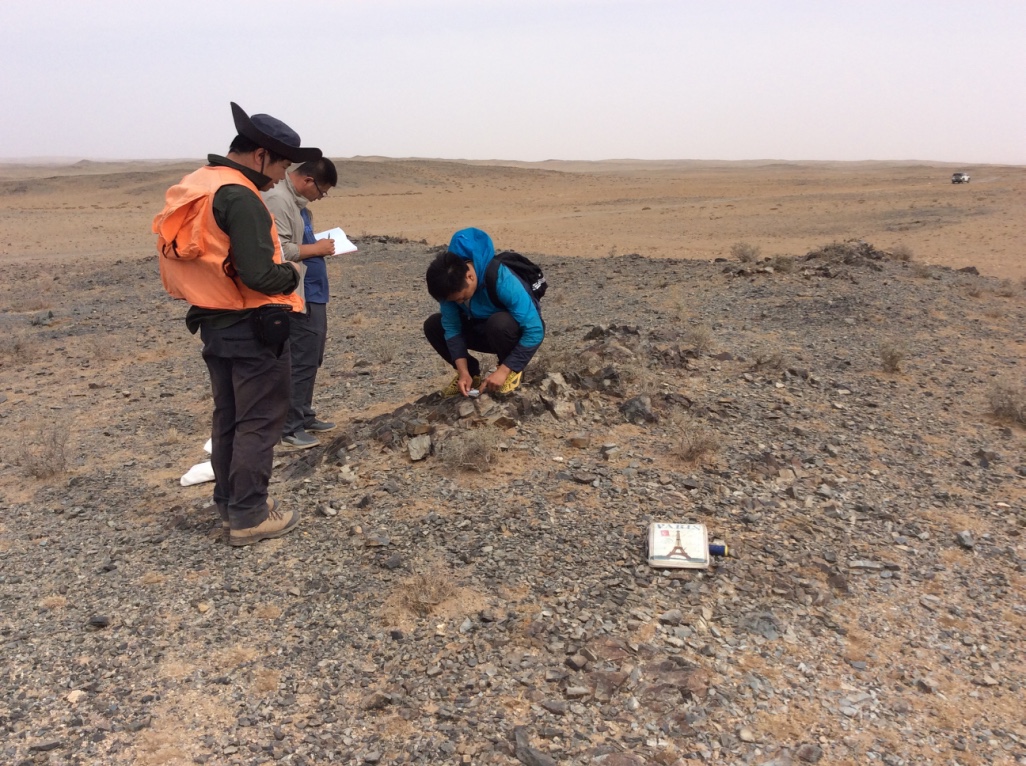
Collecting ophiolite samples in northern Inner Mongolia with doctoral students from the Chinese Academy of Geological Sciences. Prof Tong Ying on left (photo: Simon Wilde).
See Research highlights:
Volatile elements and metasomatism: how to move things around in the lithosphere
Published outputs for 2018
CCFS Publications: #950, 1036, 1041, 1250, 1252, 1254, 1256, 1258, 1260, 1262, 1265, 1266, 1268, 1271, 1273, 1276, 1280, 1281, 1285, 1290, 1291, 1292, 1295, 1296, 1298, 1300, 1335, 1336, 1337, 1338, 1339, 1340
9 Conference Abstracts

7. PRECAMBRIAN ARCHITECTURE AND CRUSTAL EVOLUTION IN WA
Themes 1, 2 and 3, Early Earth, Earth’s Evolution and Earth Today, contributing to understanding Earth’s Architecture.
AIMS
The enormous size and limited outcrop of the Neoarchean Yilgarn Craton and the Proterozoic orogens around its margins are detrimental to a deep understanding of what controls the distribution of mineral resources and which geodynamic processes were involved in the tectonic assembly of the Australian continent. The principal aim of this program is to combine geological, geochemical and geophysical techniques to propose a 3D structural model of the lithosphere of the Yilgarn Craton and its margins. This aim is predominantly addressed through passive source seismic experiments and integrated analysis of Hf-isotope data.
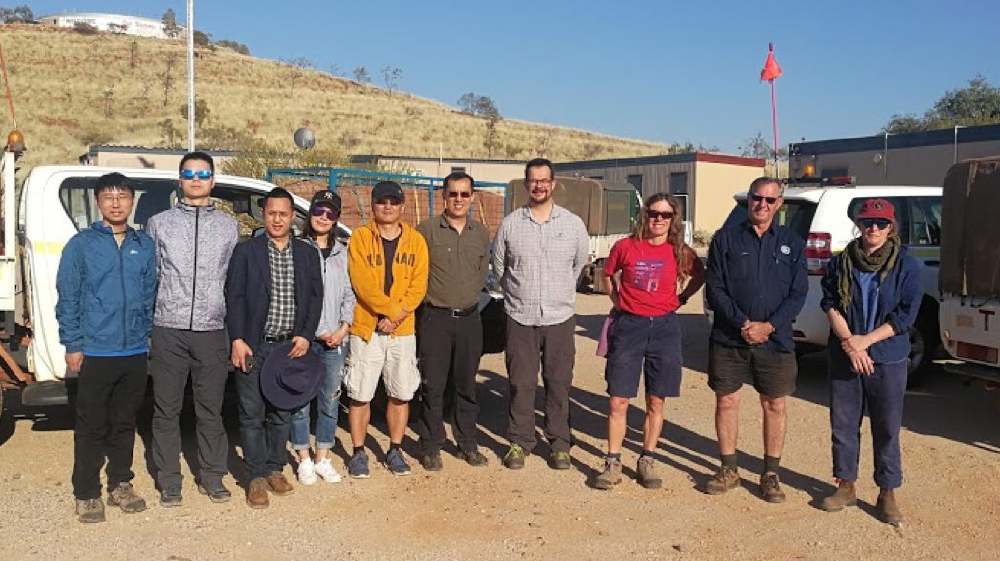
Figure 1. The CWAS Phase 2 installation team from IGG-CAS, GSWA and MQ line up before packed vehicles at Marble Bar, WA before heading out for the 38-site deployment on 21 August 2018.
2018 REPORT
In 2018, several passive-source array deployments (~70 sites) were finished, including in the Perth Basin, Phase 1 of the China-Western Australia Seismic Experiment (CWAS), and the Ocean Bottom Seismometer deployment (CANPASS) in the Canning Basin. Two new field deployments (~60 sites) started in the Eastern Goldfields and in Phase 2 of CWAS. Preparations are also underway for the acquisition of six high-resolution seismic reflection lines by the Geological Survey of Western Australia in February and March 2019. This seismic survey has been funded through the Western Australian Government’s Exploration Incentive Scheme (EIS Phase 4).
Seismic models utilising data from field deployments under Flagship 7 program started to come out as publications. The first finished field project resulted in 3 peer-reviewed journal articles this year. Various seismic models, including the Capricorn and the Perth Basin projects are currently in preparation for publication in 2019. New research activities include the source-mechanism inversion for the September 16, 2018 magnitude-5.4 earthquake at Lake Muir also commenced by CCFS visitor Dr Xiangdong Lin, Beijing Earthquake Agency.
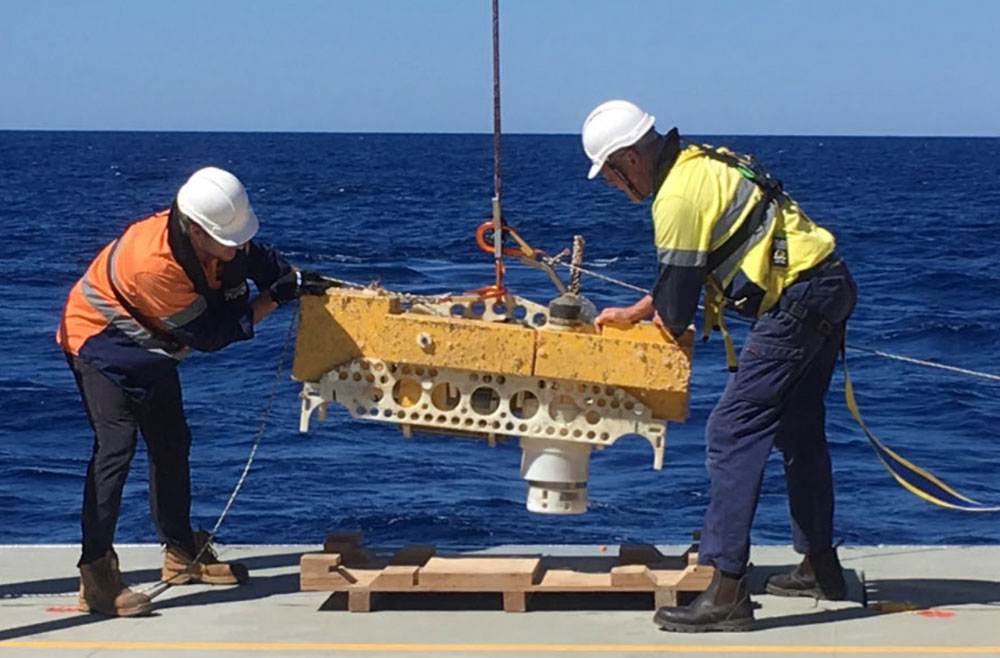
Figure 2. Recovery of an Ocean Bottom Seismometer from Australia’s North West Shelf after a 9-month deployment on the seafloor.
See Research highlights:
The physics of recent earthquakes in southwest WA
Oblique crustal structural grain in the crust beneath the Phanerozoic Perth Basin
Published outputs for 2018 CCFS Publications: #1037, 1109, 1110, 1181, 1219, 1293, 1307, 1321 10 Conference Abstracts
WHOLE OF CENTRE TECHNOLOGY DEVELOPMENT

1. CAMECA ION MICROPROBE DEVELOPMENT: MAXIMISING QUALITY AND EFFICIENCY OF CCFS ACTIVITIES WITHIN THE UWA ION PROBE FACILITY
Themes 1, 2 and 3, Early Earth, Earth’s Evolution and Earth Today, contributing to understanding Earth’s Architecture and Fluid Fluxes.
AIMS
The Ion Probe Facility within the CMCA at UWA is one of the best-equipped Secondary Ion Mass Spectrometry (SIMS) labs in the world. It houses a CAMECA IMS 1280 large-radius ion microprobe, for the high-precision analysis of stable isotopes in minerals, and two CAMECA NanoSIMS 50s for imaging mass spectrometry at the sub-micron scale. This program provides a dedicated Research Associate to facilitate CCFS activities and lead the development of standards and analytical protocols at the CMCA. This greatly benefits CCFS by increasing the capacity of the Facility, enabling a higher degree of interaction and participation on research projects, facilitating standards and protocols development, and allowing greater synergy with other CCFS node facilities.
For progress in 2018 and plans for 2019, please see Technology Development

2. FRONTIERS IN INTEGRATED LASER-SAMPLED TRACE ELEMENT AND ISOTOPIC GEOANALYSIS
Themes 1, 2 and 3, Early Earth, Earth’s Evolution and Earth Today, contributing to understanding Earth’s Architecture and Fluid Fluxes.
AIMS
The overall aim is to develop new analytical methods for in situ measurement of trace elements and isotope ratios to support and enable CCFS research programs and to provide new directions of research. Specific objectives include:
(1) combined trace element and isotope analysis - ‘split-stream’ analysis
(2) development of ‘non-traditional’ stable isotopes
(3) characterisation of reference materials for elemental and isotope ratio measurement
(4) development of data reduction software for combined trace element and isotope analysis
For progress in 2018 and plans for 2019, please see Technology Development

 ARC Centre of Excellence for Core to Crust Fluid Systems
ARC Centre of Excellence for Core to Crust Fluid Systems